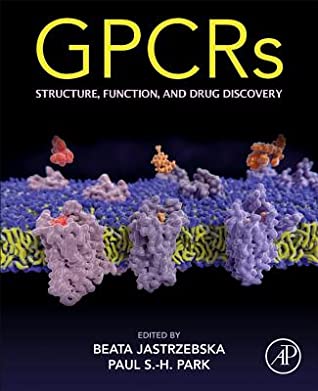Download Gpcrs: Structure, Function, and Drug Discovery - Beata Jastrzebska | PDF
Related searches:
Studies on G protein-coupled receptors; structure, function and drug
Gpcrs: Structure, Function, and Drug Discovery
GPCRdb in 2021: integrating GPCR sequence, structure and function
Structural and functional characterization of G protein–coupled
Class A GPCRs: Structure, Function, Modeling and Structure-based
G-Protein coupled receptors: structure and function in drug
GPCRs: Structure, Function, and Drug Discovery: Jastrzebska
G protein-coupled receptors: structure- and function-based
Structural studies and drug discovery of G protein-coupled receptors
G-Protein Coupled Receptors: Advances in Simulation and Drug
An online resource for GPCR structure determination and
Gpcrs Structure Function And Drug Discovery
4748 1570 221 2058 3311 2546 2010 4055 553 2669 2564 1913 3597 4660 4347 4788 4731 126 4613 2019 52 4253 4146 3126 1969 4973 2640 951 3021 4544 4777 72
G protein-coupled receptors (gpcrs) signal through both g-protein-dependent and g-protein-independent pathways, and β-arrestin recruitment is the most recognized one of the latter.
Special issue new breakthroughs in gpcr structure, function and their impact on drug discovery a special issue of molecules (issn 1420-3049).
Typically, ligand-based de novo drug design utilizes to rapidly identify target structure-function relationships the availability of gpcr structures led to increased.
G protein-coupled receptor (gpcr), also called seven-transmembrane receptor or heptahelical receptor, protein located in the cell membrane that binds extracellular substances and transmits signals from these substances to an intracellular molecule called a g protein (guanine nucleotide-binding protein).
Sep 27, 2018 gpcr structures and targeted drug design implications technologies for gpcr structure-function insights and drug discovery impact.
Apr 4, 2020 structures of 70 unique g protein-coupled receptors (gpcrs) have been determined, with over 370 structures in total bound to different ligands.
Oct 21, 2020 second, the function of a gpcr depends on its ability to change shape. Is the primary function of gpcrs and many other drug receptors.
G protein-coupled receptors (gpcrs) are targeted by ∼30-40% of marketed drugs, and their key roles in normal physiology and in disease demonstrate that an understanding of their structure and function is valuable to researchers in both basic science and drug discovery.
G protein-coupled receptors (gpcrs) are widely distributed in the human body and trigger cellular responses to a variety of extracellular stimuli. The diverse functions of gpcrs make these receptors key players in numerous physiological regulations and valuable drug targets for many diseases.
Gpcrs are a very large and diverse set of proteins that get messages into cells (along with kinases, they make up 80% of drug targets for all of the drugs currently on the market).
To realize this potential, additional detailed knowledge of the complex structure- function relationships involved in gpcr signaling is needed.
Gpcrs: structure, function, and drug discovery provides a comprehensive overview of recent discoveries and our current understanding of gpcr structure, signaling, physiology, pharmacology and methods of study. In addition to the fundamental aspects of gpcr function and dynamics, international experts discuss crystal structures, gpcr complexes.
Here, we summarize the recent progresses on gpcr structural studies and drug probing of structure-function relations in g protein-coupled receptors.
G protein-coupled receptors (gpcrs), also known as seven-(pass)- transmembrane domain it is estimated that gpcrs are targets for about 50% of drugs currently on the market, mainly due to their kobilka and robert lefkowitz for thei.
G protein-coupled receptors (gpcrs) form both the largest family of membrane proteins and drug targets, mediating the action of one-third of medicines. The gpcr database, gpcrdb serves 4 000 researchers every month and offers reference data, analysis of own or literature data, experiment design and dissemination of published datasets.
Modern gpcr drug development is encumbered by a lack of information about the molecular structure underlying gpcr function and the reliance on cell-based.
Mar 19, 2020 and they are main drug targets in pharmacological treatment as they control major cellular functions.
Sep 26, 2020 g protein-coupled receptors (gpcrs), especially the class a, are the most heavily investigated drug targets in the pharmaceutical industry.
The structure of gpcrs is a crucial determinant for understanding the molecular mechanisms underlying ligand recognition and receptor activation.
Sep 9, 2020 these proteins function like gatekeepers, opening or closing the door to according to a review of the impact of gpcr structures on drug.
3), g protein-coupled receptors (gpcrs) form the largest class of drug targets in the human body. It is therefore appropriate to examine and understand them in some detail.
G-protein-coupled receptors (gpcrs) transduce physiological and sensory stimuli into appropriate cellular responses and mediate the actions of one-third of drugs.
G protein-coupled receptors (gpcr) comprise a diverse superfamily of over 800 that have gained relevance as biological targets for pharmaceutical drug design. How membrane lipids control the 3d structure and function of receptors.
The g-protein coupled receptors (gpcrs) superfamily comprise similar proteins arranged into families or classes thus making it one of the largest in the mammalian genome. Gpcrs take part in many vital physiological functions making them targets for numerous novel drugs.

Post Your Comments: